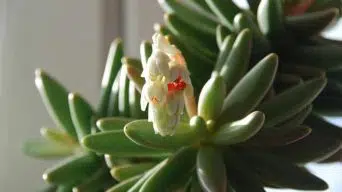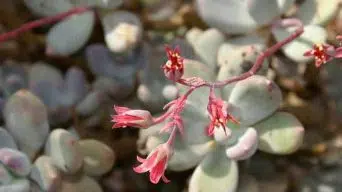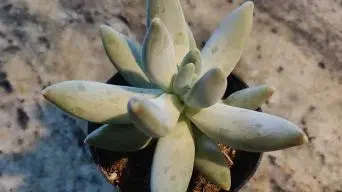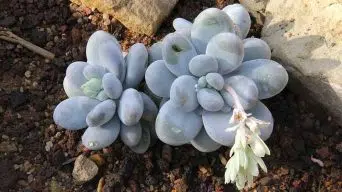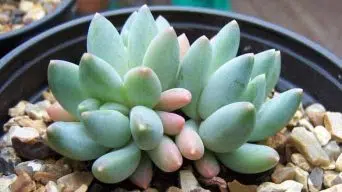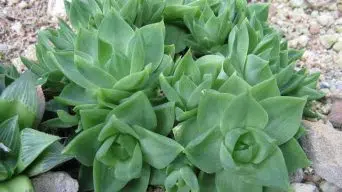Pachyphytum hookeri succulents are very simple plants to grow, but there are some things you should know about them before caring for them properly.
These include their natural environment, preferred soil type, water requirements, sunlight needs, and other important considerations for good Pachyphytum growth.
Pachyphytum hookeri care can be a little tricky because of their specific needs, but this guide will help you take care of your Pachyphytum so they flourish in your home or garden.
Overview
Pachyphytum hookeri are slow-growing flowering plants in the genus Pachyphytum of the family Crassulaceae, native to Mexico.
The Pachyphytum Hookeri is a small succulent plant with long, thick leaves and grows in rosettes with stems that reach up to 20 inches (50 cm).
Rosettes are loosely grouped leaves with various colors, including green, orange, and purple.
The Pachyphytum hookeri has a late summer flowering period producing small green or red bell-shaped flowers that grow at the top of long stems and are usually found on the tip of the stem.
How To Care for Pachyphytum Hookeri
Pachyphytum hookeri care is relatively simple, and Pachyphytum hookeri plants are hardy, making it ideal for beginner succulent growers.
Below you’ll find the most essential information you need to know about caring for Pachyphytum hookeri.
Sun Exposure & Light Requirements
Pachyphytum hookeri succulent plants do best in full sun or partial shade.
Pachyphytum hookeri does not do well in deep shade, especially if you live in a hot, humid climate.
Partial shade means Pachyphytum hookeri will receive partial sun (morning or afternoon) for about six hours on an average day during the summer months.
Pachyphytum hookeri does well with filtered light and can take some direct sun each day without burning or needing extra watering.
When grown indoors, Pachyphytum hookeri is best placed in a west-facing window with lots of bright sunlight during the day.
Try to keep Pachyphytum hookeri away from the hottest part of your home or a very bright east-facing window where there is direct sunlight. Pachyphytum hookeri needs some light shade during the day.
If you’d like Pachyphytum hookeri to get more sun exposure than partial shade, place Pachyphytum hookeri plants in an area that gets three to six hours of direct sunlight each day.
This way, Pachyphytum hookeri can receive enough sun while still getting some protection from intense, hot midday rays.
Watering Requirements
The Pachyphytum hookeri succulent requires a specific water level and must be watered sparingly so that the soil can dry out before being watered again.
Pachyphytum hookeri should be watered once every 1-2 weeks.
These succulents can survive drought conditions but may suffer from tip burn and disfigurement if subjected to extended periods without water.
Pachyphytum hookeri succulents planted outdoors need more water than those kept indoors because they will dry out faster when left unwatered for an extended period.
They grow well with infrequent deep watering rather than frequent light watering.
This succulent should not be allowed to sit in water and should only be watered from the base of the plant.
Pachyphytum hookeri succulents can rot if their soil stays wet, so make sure you water them only when they are dry.
Make sure not to get water on the leaves, and overwatering them will also lead to rotting.
Soil Requirements
The Pachyphytum hookeri requires well-draining soil like a cactus or succulent potting mix. It will also do well in a garden mixture of sand and loam.
If you have sandy soils, they work best for Pachyphytum because fine sand particles retain the least amount of water.
Pachyphytum will not do well if you have clay soils because they hold too much water. Pachyphytum is a succulent that stores water in its leaves and roots.
Clay soils like bonsai soil tend to keep the Pachyphytum plant in moist potting soil. That would be bad for Pachyphytum plants, or any other succulent for that matter since it can rot if you have soggy soil conditions over an extended period.
Temperature and Humidity
Pachyphytum hookeri can grow easily in any environment, but it needs temperatures of 68° – 80° Fahrenheit and nights of 50° – 70° Fahrenheit.
It can withstand around 5° Fahrenheit of frost but is sensitive to temperatures below 40° Fahrenheit.
This plant has also been shown to do best in environments with around 40% relative humidity.
Pachyphytum hookeri has been known to grow easier in low-humidity environments than in high-humidity.
Fertilizing
Pachyphytum Pachyphytum hookeri is a succulent plant that needs to have proper fertilization.
Usually, this plant will grow slowly, so you don’t need to fertilize it too much, but you can still fertilize it once a year to promote the best possible growth rate.
The Pachypyhtym Pachyphytum hookeri succulent only needs fertilizing once a month during the growing season and should be done with diluted fertilizer for cacti.
This plant is extremely sensitive to fertilizer, so it needs very little. Pachypyhtum Pachyphytum hookeri will not grow well with too much fertilizer, and the leaves will become droopy.
Potting and Repotting
Pachyphytum hookeri potted plants thrive best in small pots with drainage holes or slits made of pottery or plastic material.
If you decide to use your Pachyphytum hookeri plants as indoor succulent plants, you have to place them on shallow and wide potteries for proper soil aeration.
Pots should be at least one inch higher than the normal size. Pots with holes or slits are best for Pachyphytum hookeri plants, which helps with air circulation and drainage.
The Pachyphytum hookeri plant’s roots can become easily damaged, so take care not to disturb its root system when repotting Pachyphytum hookeri by using a bigger pot than its current size.
Repot Pachyphytum hookeri when you see roots coming out of the lower side of the container or if they have grown into a ball and hindered its growth.
They require repotting to prevent it from breaking.
It would help if you replanted potted Pachyphytum succulents immediately after purchase to avoid any damage to root systems.
Pruning
Pachyphytum Hookeri is a slow grower, and you won’t need to prune much, perhaps just once every few years.
Generally, the Pachyphytum hookeri succulent doesn’t need to be pruned. You just need to remove any leaves which have died or have been damaged.
If your Pachyphytum Hookeri succulents have become too large for your liking, you can trim Pachyphytum Hookeri down.
Pachyphytum hookeri can be left to grow as single rosettes or trimmed into bushy shapes.
Pests and Diseases
Pachyphytum hookeri succulents are susceptible to pests and diseases, such as mealybugs and root rot.
Mealybugs
Pachyphytum hookeri succulents are attacked by mealybugs, tiny, soft-bodied, whitish insects.
Mealybugs feed on plant juices and secrete honeydew, attracting sooty mold covering your Pachyphytum hookeri succulent leaves.
You can successfully treat Pachyphytum hookeri succulents for mealybugs by washing them in a mixture of water and mild dish soap.
Root Rot.
Pachyphytum hookeri succulents succumb to root rot if they are overwatered or if the air humidity around your succulent remains high for long periods.
They suffer from root rot when their roots are exposed to too much moisture over time.
Pachyphytum hookeri succulents that succumb to root rot lose the lower leaves first, which wilt and turn yellow. Succulents with root rot die if you do not treat them.
Pachyphytum hookeri succulents need air circulation to treat root rot, and you should transplant them to pots with well-drained soil.
How to Care for Pachyphytum Hookeri in Winter
Pachyphytum hookeri does not need any special care in winter, but there are some steps you can take to make sure your Pachyphytum hookeri survives the harsh weather conditions.
- Leave the Pachyphytum hookeri outdoors as long as there are no signs of frost or temperatures above 0°C or 30°F.
- Pachyphytum hookeri can withstand temperatures as low as -4°C / 25°F, but it will drop its leaves when exposed to cold for too long.
- Take the Pachyphytum hookeri indoors when temperatures drop below 4°C/25°F or when you see the first signs of frost.
- Provide Pachyphytum hookeri with bright light but no direct sun.
- Pachyphytum hookeri are sensitive to cold draughts and excessive heat, so make sure Pachyphytum hookeri is placed in a warm, draft-free spot.
- Pachyphytum hookeri does not need any extra water; only let the soil become moderately dry before you water it again.
How To Propagate Pachyphytum Hookeri
Pachyphytum hookeri succulent plants can be propagated by leaf cuttings and stem cuttings.
Leaf Cuttings
To propagate Pachyphytum hookeri, you have to remove a leaf from the mother plant.
Allow the cut end of the leaf you take off from the plant to callous for a few days. Keep it away from direct sunlight and keep it moist but not wet.
Cuttings can be planted two weeks after you take them off.
Stem Cuttings
You can also use stem cuttings to propagate this succulent plant.
Remove the lower leaves of your stem cutting, leaving only the top leaves on it.
The stem you remove should have some roots on it.
Place this in a slightly moist, well-draining soil mix, and you can plant your stem into the ground or pot it up as you would with any other succulent cutting.
Make sure you keep it watered but do not overwater it (keep your soil mix on the dry side).
It’s possible you could see your plant start to grow roots within a few days of planting it.
Is the Pachyphytum Hookeri Toxic?
The Pachyphytum hookeri plants are considered non-toxic to people and animals.
However, it would be best if you took some precautions.
The sap of the Pachyphytum hookeri plant contains calcium oxalate crystals, which are the same as in rhubarb, and you should not ingest them.
If possible, gloves should always be used when handling the Pachyphytum hookeri plant.
Final Thoughts
The Pachyphytum hookeri plant can be used as an ornamental houseplant for its attractive appearance or as a groundcover in dry climates where it does not need much water.
It is also useful in rock gardens because it tolerates poor soil conditions well and will grow among rocks without being disturbed by them.
It is often grown indoors as an ornamental plant because it requires little care other than occasional watering when necessary during periods of drought.
This makes it very easy to maintain, making this plant perfect for people who don’t have time to take care of plants but still want one around their home!


